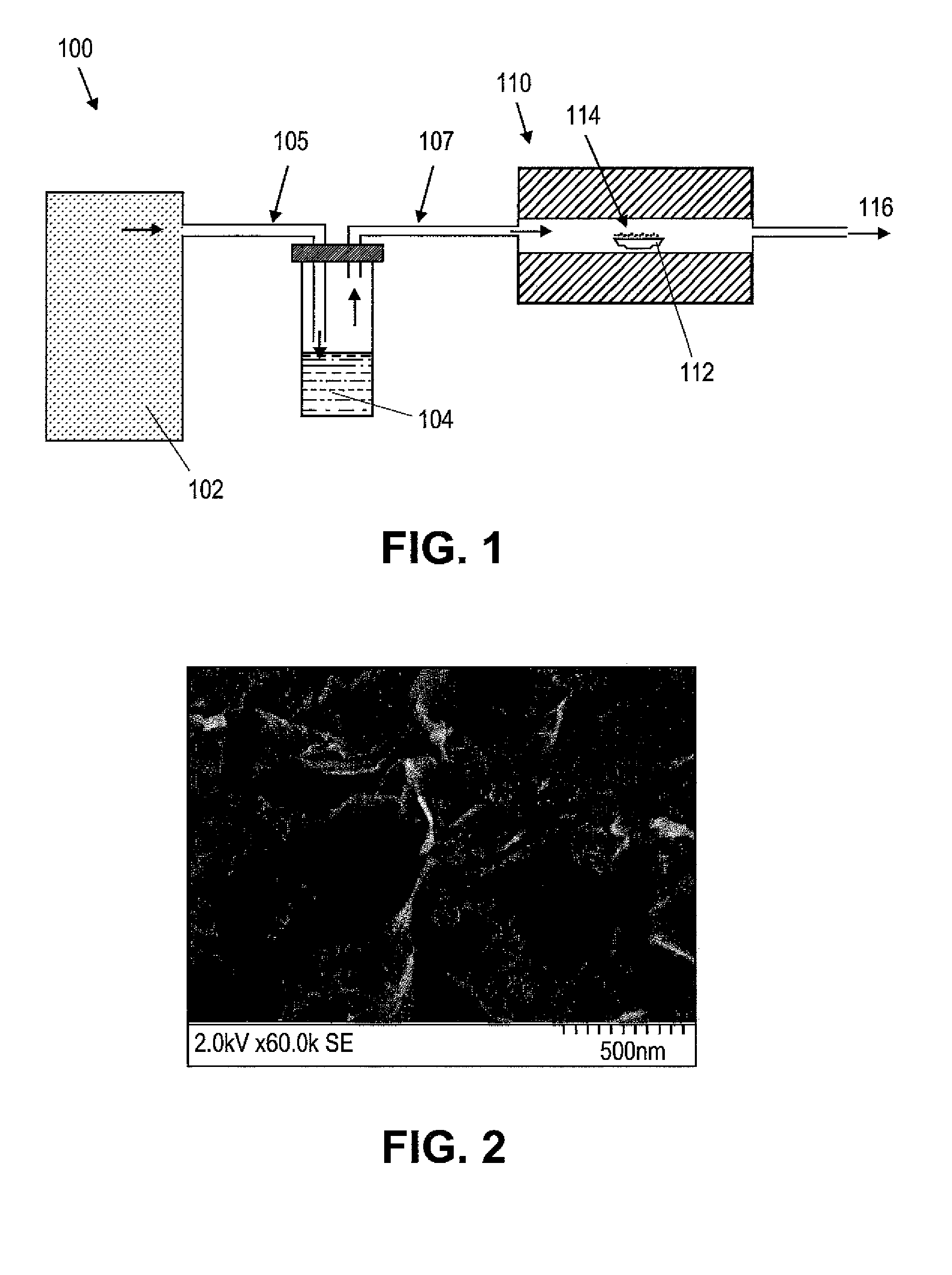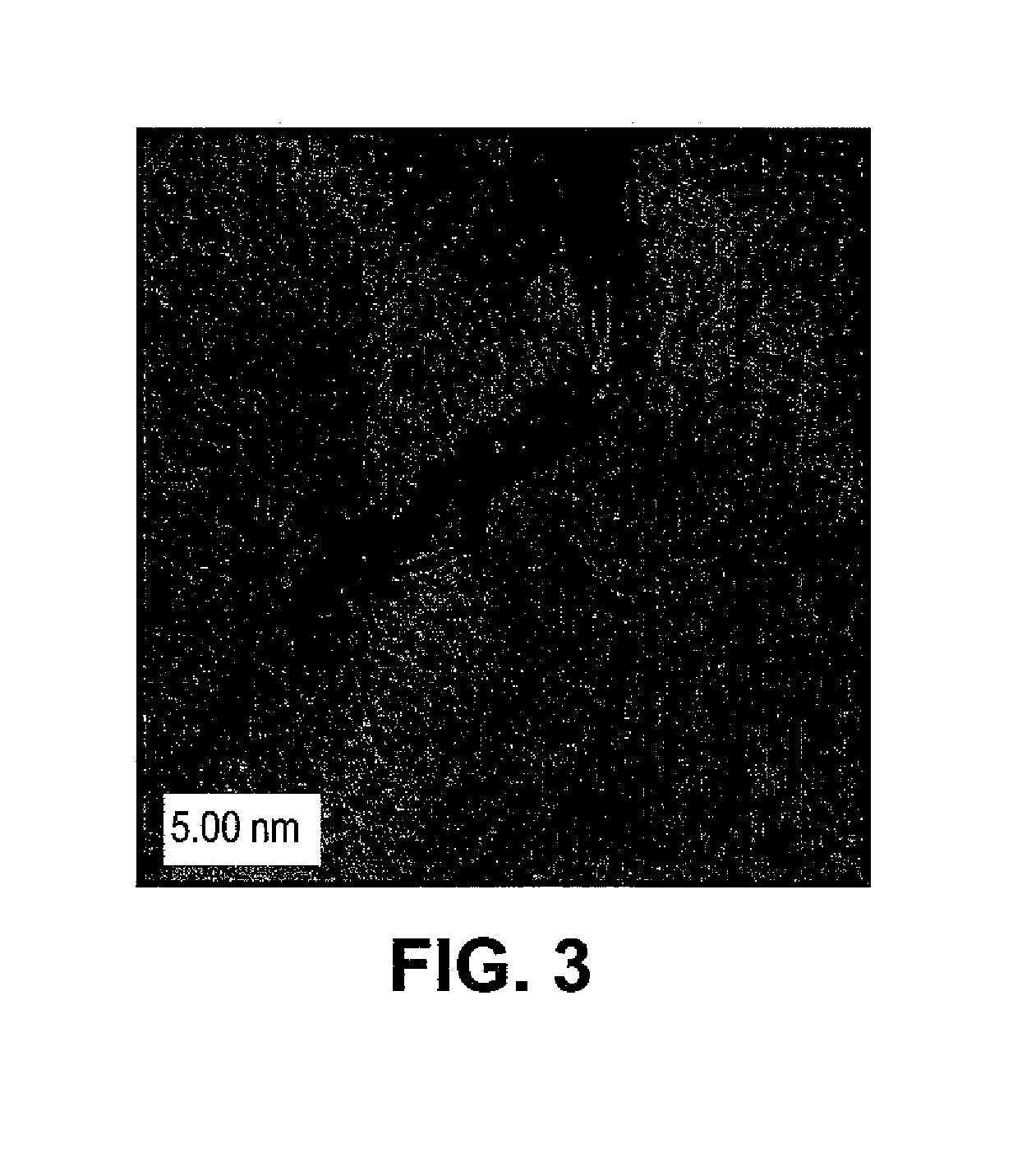Synthetic methods for generating WS2 nanostructured materials
a nanostructured material and nanotechnology, applied in the field of nanostructured materials, can solve the problems of toxic, corrosive, high flammability, common sulfur precursor for the synthesis of wssub>2 /sub>from wosub>3 /sub>,
- Summary
- Abstract
- Description
- Claims
- Application Information
AI Technical Summary
Problems solved by technology
Method used
Image
Examples
example 1
Formation of WS2 Flakes with a Thickness in Nanometer Scale
[0032]Synthesis was started by placing micron sized WO3 particles (Sigma-Aldrich Corp., St. Louis, Mo.) in a ceramic boat inside a quartz tube into a tubular furnace Model 3210 (Applied Test Systems, Inc., Butler, Pa.). The system was then closed with stainless steel lids amid tubing connectors that directed argon stream into the quartz tube. The location of the precursor materials were coincided with the central heating zone of the furnace. A trap containing liquid CS2 was then placed between the Ar source and the furnace. Hosing was connected in a manner such that the CS2 vapor was carried with the Ar stream into the quartz tube, and Ar flow rate was adjusted to be about 6.27 slpm. The furnace was then heated to a temperature of about 750° C. with a constant supply of the argon and CS2 mixture and the reaction of the WO3 precursor nanoparticles with CS2 vapor in the quartz tube was allowed to continue for about 2 hours. In...
example 2
Formation of WS2 Nanofibers
[0033]The procedure of Example 1 was repeated with the exception of reaction time. When the reaction time was increased to be about 5 hours, WS2 nanofibers were formed from the reaction of the WO3 precursor nanoparticles with CS2 vapor. The resulting product included at least about 5% of WS2 nanofibers as well as production of WS2 flakes. FIG. 3 depicts an exemplary TEM image results of WS2 nanofibers obtained when the reaction time was about 5 hours in accordance with the present teachings.
example 3
Formation of WS2 nanoparticles
[0034]The procedure of Example 1 was repeated with the exception of reaction time. In this example, the reaction time was increased to about 24 hours for the reaction between WO3 precursor nanoparticles and CS2 vapor in the quartz tube. WS2 nanoparticles were obtained after the 24-hour reaction. Also, at least about 20% of the nanoparticles possessed inorganic fullerene like structures. As an example, FIG. 4 depicts a TEM image of a WS2 nanoparticle obtained when WO3 was treated in an Ar / CS2 atmosphere at about 750° C. for about 24 hours in accordance with the present teachings. In particular, the TEM image shows lattice fringes corresponding to WS2 structure and an empty core characteristic of WS2 semispherical nanostructures.
PUM
| Property | Measurement | Unit |
|---|---|---|
| Temperature | aaaaa | aaaaa |
| Temperature | aaaaa | aaaaa |
| Length | aaaaa | aaaaa |
Abstract
Description
Claims
Application Information
 Login to View More
Login to View More - R&D
- Intellectual Property
- Life Sciences
- Materials
- Tech Scout
- Unparalleled Data Quality
- Higher Quality Content
- 60% Fewer Hallucinations
Browse by: Latest US Patents, China's latest patents, Technical Efficacy Thesaurus, Application Domain, Technology Topic, Popular Technical Reports.
© 2025 PatSnap. All rights reserved.Legal|Privacy policy|Modern Slavery Act Transparency Statement|Sitemap|About US| Contact US: help@patsnap.com



